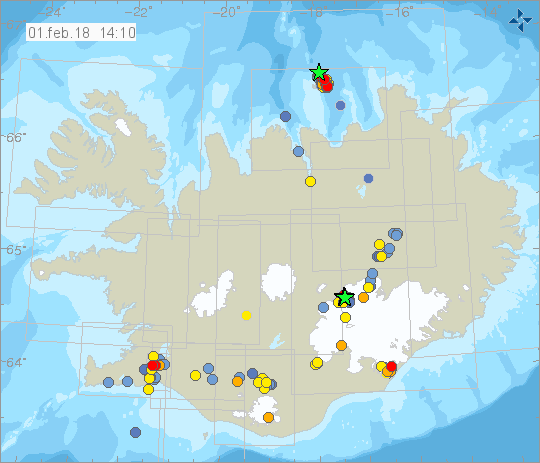The earthquake swarm around Grímsey island, Iceland's northernmost settlement, continued yesterday, with a sharp earthquake swarm yesterday afternoon, culminating in a 3.2 magnitude quake at 20:20 yesterday evening.
The swarm is not believed to be connected to growing likelihood of volcanic activity.

Several powerful swarms
The swarm began on Saturday morning with a sharp 4.1 magnitude quake. A second 3.4 magnitude quake hit shortly thereafter, followed by more than 170 separate tremors. Since then the island has experienced a few smaller swarms, the largest hitting on Wednesday morning.
Read more: Why the constant earthquakes? Iceland is slowly being torn apart
The quakes have been felt clearly in Grímsey island, which is home to 90 people, and around Eyjafjörður fjord on the mainland.
The earthquakes are caused by energy being released from the earth's crust. Grímsey sits on the Tjörnes rift zone, which is part of the North Atlantic Ridge where the North American and Eurasian tectonic plates drift in opposite directions.
The area known for high geological activity and frequent earthquake swarms, as well as geothermal and volcanic activity.
The earthquake swarm around Grímsey island, Iceland's northernmost settlement, continued yesterday, with a sharp earthquake swarm yesterday afternoon, culminating in a 3.2 magnitude quake at 20:20 yesterday evening.
The swarm is not believed to be connected to growing likelihood of volcanic activity.

Several powerful swarms
The swarm began on Saturday morning with a sharp 4.1 magnitude quake. A second 3.4 magnitude quake hit shortly thereafter, followed by more than 170 separate tremors. Since then the island has experienced a few smaller swarms, the largest hitting on Wednesday morning.
Read more: Why the constant earthquakes? Iceland is slowly being torn apart
The quakes have been felt clearly in Grímsey island, which is home to 90 people, and around Eyjafjörður fjord on the mainland.
The earthquakes are caused by energy being released from the earth's crust. Grímsey sits on the Tjörnes rift zone, which is part of the North Atlantic Ridge where the North American and Eurasian tectonic plates drift in opposite directions.
The area known for high geological activity and frequent earthquake swarms, as well as geothermal and volcanic activity.







